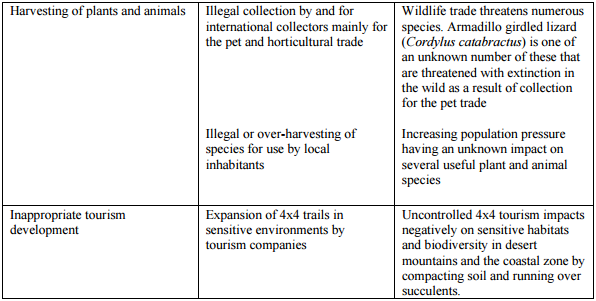
Introduction:
Biodiversity is the presence of many distinct species of plants and animals within an ecosystem. Biodiversity is important because different species do different things, so a large amount of them means lots of species are performing different roles, and benefitting the ecosystem in their own way. The biodiversity hotspot we selected is the Succulent Karoo. The Succulent Karoo is classified as a biodiversity hotspot because it is rich many different species, and is in danger of being destroyed.
Background information:
The Succulent Karoo is a large desert region, stretching from the southwest corner of Namibia to the west of South Africa. It is the most diverse arid desert region in the world. It is classified as an extreme desert biome, with very low net primary productivity of only around 100. It has more than 6000 different plant species, 250 birds, 78 mammals, and 132 reptiles and amphibians. The Northern area, called Namaqualand, receives very little rainfall, however the Southern Karoo experiences rainfall in the spring and fall.
Food Web: Succulent Karoo
"Succulent Karoo." Food Webs of South Africa. Web. 14 Dec. 2015. <http://safoodwebs.weebly.com/succulent-karoo.html>
Discussion:
The main natural service is food for animals due to the large amount of plant species. It also provides many economic services such as tourism, ostrich farming, and mining. Most environmental degradation comes from diamond mining, which has destroyed much of the landscape. More than 60% of the west coast has been mined. Diamonds are very popular around the world, so people mine them from this hotspot for money. Overgrazing from ostriches has also hurt the ecosystem by damaging its soil. Because of this, fewer plants are able to grow. Originally, this hotspot covered over 100,000 square kilometers, but it now covers less than 30,000. Not much is being done to restore the Succulent Karoo. Organizations like SKEP (Succulent Karoo Ecosystem Program) and CEPF (Critical Ecosystem Partnership Fund) have helped convert areas to National Parks, however, only 3.5% of the hotspot is formally conserved.
Web. 13 Dec. 2015.<http://www.cepf.net/Documents/final.succulentkaroo.briefingbook.pdf>.
 Conclusion:
Conclusion:
The Succulent Karoo is an incredibly diverse region, that is under attack. Mining and ranching have destroyed most of the region. We can help by working with organizations such as SKEP and CEPF to protect more of its land. Another way we can help is by buying fewer precious minerals like diamonds, since mining for these resources is the main cause of degradation to the Succulent Karoo hotspot. If we don’t act now, the world’s most important desert could be lost forever.










